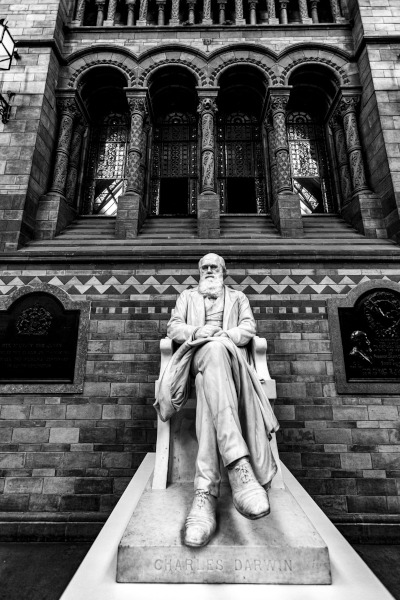Charles Darwin’s groundbreaking work, “On the Origin of Species,” published in 1859, stands as a pivotal moment in the history of science, revolutionizing the field of biology and reshaping our fundamental understanding of the natural world. In this exploration of Darwin’s legacy, we delve into the enduring impact of his theory of evolution by natural selection and the profound transformations it brought to scientific thought and societal perspectives. Despite facing skepticism at the time, Darwin’s ideas challenged prevailing beliefs about fixed species and introduced the concept of evolution.
Evolutionary Awakening Amidst Scientific Skepticism
At the time of its release, “On the Origin of Species” faced considerable skepticism within both the scientific community and the public. The prevailing belief in fixed and unchanging species, often attributed to divine creation, posed a formidable challenge to the acceptance of evolution. Scientists and scholars of the time were deeply entrenched in long-standing doctrines that upheld the fixity of species, rooted in religious and philosophical ideologies.
Darwin’s revolutionary ideas presented a seismic shift, challenging not only the scientific status quo but also the deeply ingrained societal and religious perspectives. The prevailing sentiment among many scientists was skepticism, with a reluctance to abandon traditional views that had dominated scientific discourse for centuries. The concept of species evolving over time, guided by natural processes rather than divine intervention, was met with apprehension.
Despite these challenges, “On the Origin of Species” presented a compelling array of evidence, ranging from fossil records to observations of artificial selection, effectively challenging the prevailing beliefs. Darwin’s meticulous documentation of the variability of species and the impact of environmental factors on traits laid the groundwork for a new paradigm in biological understanding.
The scientific skepticism of the time, deeply rooted in religious and cultural norms, provided a formidable backdrop against which Darwin’s evolutionary theory emerged. The clash between established dogmas and the groundbreaking ideas presented in the book set the stage for a transformative period in the history of science.
Key Concepts of Darwin’s Theory
Central to Darwin’s revolutionary theory is the concept of natural selection, a process wherein certain traits become more prevalent in a population over time due to their survival and reproductive advantages. Darwin’s meticulous observations and extensive research during his voyage on the HMS Beagle laid the foundation for these key concepts that form the bedrock of evolutionary biology.
- Variation Within Populations: Darwin argued for the essential role of variation within populations, underscoring the richness of biological diversity. He contended that this variation serves as the raw material upon which natural selection acts, driving the evolutionary process forward.
- Environmental Influence on Traits: A groundbreaking aspect of Darwin’s theory is the proposition that the environment plays a crucial role in shaping the traits of organisms. This concept introduced the idea of adaptation, where individuals with traits best suited to their surroundings are favored by natural selection. This ensures the transmission of advantageous traits to successive generations, a fundamental mechanism guiding the evolution of species.
- Common Descent and the Tree of Life: The captivating narrative of a unified “tree of life” introduced by Darwin is rooted in the evidence supporting the idea that all living organisms share a common ancestor. This branching pattern of evolution illustrates the interconnectedness of all species, providing a comprehensive framework for understanding the evolutionary relationships among living organisms.
- Fossil Evidence and Evolutionary History: Delving into the fossil record, Darwin provided a historical snapshot, tracing the evolution of different species over millions of years. This tangible evidence showcased a gradual increase in the complexity of life forms and solidified the idea of common descent. Fossils became a window into the past, offering glimpses of evolutionary transformations.
- Artificial Selection and its Wild Counterpart: A vivid illustration of the workings of natural selection in the wild was presented through Darwin’s exploration of artificial selection. By examining how humans, through selective breeding, could mimic the forces of nature, Darwin offered tangible proof of the transformative power of selection. This comparison served to bridge the gap between the artificial and the natural, reinforcing the universality of evolutionary principles.
- Geographical Distribution and Evolution: Darwin’s examination of the geographical distribution of species shed light on how different environments led to the development of distinct traits. This aspect of his theory elucidated the intricate relationship between geography and evolution, emphasizing the dynamic interplay between the natural world and the evolutionary process.
Evolution’s Ongoing Influence on Modern Biology
Over the years, Darwin’s theory of evolution has undergone refinement and development, yet it remains a cornerstone of modern biology. A 2013 survey by the Pew Research Center revealed that 60% of Americans believe in evolution, highlighting its enduring impact. Similarly, a 2019 survey in the United Kingdom reported a significant 77% belief in evolution. Despite its widespread acceptance, the theory continues to stir controversy, particularly with movements advocating alternative theories like intelligent design in educational settings.
Navigating Controversy and Upholding Scientific Integrity
While the theory of evolution faces occasional challenges and controversies, the scientific community staunchly defends its validity. Recent debates, especially regarding alternative theories in educational curricula, underscore the ongoing importance of upholding evidence-based thinking and scientific rigor.
Undeniable Legacy
The legacy of “On the Origin of Species” transcends its immediate impact. It ignited a scientific revolution, challenging preconceived notions and prompting a reevaluation of humanity’s place in the natural order. Today, it stands as a powerful reminder of the critical role evidence-based thinking plays in the pursuit of knowledge.
Background information
Charles Darwin was an English naturalist and biologist who lived from 1809 to 1882. He is best known for his work on the theory of evolution by natural selection, which he introduced in his book On the Origin of Species (Darwin 1859).

Darwin’s ideas were shaped by the scientific and cultural context of the time. During the 19th century, there was a growing interest in the natural world and a desire to understand how it worked. This led to a number of scientific expeditions and discoveries, including Darwin’s famous voyage on the HMS Beagle.
During his five-year journey on the Beagle, Darwin collected a vast amount of data on the natural world, including fossils, plants, and animals. This experience gave him a firsthand understanding of the diversity of life on Earth and the processes that shape it.
After returning from his voyage, Darwin spent many years researching and developing his ideas about evolution. He corresponded with other scientists, conducted experiments, and collected more data to support his theories.
In 1859, Darwin published On the Origin of Species, which presented his theory of evolution by natural selection. The book was controversial at the time, as it challenged many of the prevailing beliefs about the natural world and the origins of life.
Despite this controversy, On the Origin of Species had a profound impact on the scientific community and the public. It provided a framework for understanding the natural world that has continued to be refined and developed over the years.
Today, Darwin’s legacy continues to be felt in a number of ways. For example, the study of evolution has become a major field of scientific research, with new discoveries and insights being made all the time. In addition, the theory of evolution has had a significant impact on other fields of study, including genetics, psychology, and anthropology.
The Evolutionary Landscape Unveiled: On the Origin of Species Overview
“On the Origin of Species,” a groundbreaking work published in 1859, stands as one of the most pivotal scientific writings in history. Its profound impact is rooted in Charles Darwin’s revolutionary theory of evolution by natural selection, a mechanism now widely accepted as the driving force behind species’ transformation over time (Darwin 1859).
The book, organized into 14 chapters, unfolds a narrative that challenges entrenched beliefs about the natural world. Let’s delve into the key themes and ideas presented by Darwin, illuminating the foundational concepts that continue to shape our understanding of evolution.
Key Themes Explored by Darwin
- Variation Within Populations: Darwin’s argument for the essential role of variation within populations underscores the richness of biological diversity. This variation, he contended, serves as the raw material upon which natural selection acts.
- Environmental Influence on Traits: The proposition that the environment plays a crucial role in shaping the traits of organisms introduces the concept of adaptation. Individuals with traits best suited to their surroundings are favored by natural selection, ensuring the transmission of advantageous traits to successive generations.
- Common Descent and the Tree of Life: The captivating narrative of a unified “tree of life” introduced by Darwin is rooted in the evidence supporting the idea that all living organisms share a common ancestor. This branching pattern of evolution illustrates the interconnectedness of all species, providing a comprehensive framework for understanding the evolutionary relationships among living organisms.
- Fossil Evidence and Evolutionary History: Delving into the fossil record, Darwin provided a historical snapshot, tracing the evolution of different species over millions of years. This tangible evidence showcased a gradual increase in the complexity of life forms and solidified the idea of common descent.
- Artificial Selection and its Wild Counterpart: The exploration of artificial selection by humans in domesticated plants and animals served as a vivid illustration of the workings of natural selection in the wild. Humans, through selective breeding, mimicked the forces of nature, offering tangible proof of the transformative power of selection.
- Geographical Distribution and Evolution: Darwin’s examination of the geographical distribution of species shed light on how different environments led to the development of distinct traits. This aspect of his theory elucidated the intricate relationship between geography and evolution.
Evolution’s Ongoing Influence on Modern Biology
In the ever-evolving landscape of evolutionary biology, Darwin’s ideas persist as guiding principles. The legacy of “On the Origin of Species” reverberates through contemporary scientific inquiry, influencing researchers and shaping new insights into the intricate mechanisms of evolution.
Recent discoveries, advanced technologies, and interdisciplinary approaches have expanded our understanding, offering fresh perspectives on the complex dance between genetic variation, natural selection, and environmental dynamics. This ongoing relevance is not confined to academic discourse; it resonates in practical applications, influencing fields like medicine, agriculture, and conservation.
The dynamic nature of Darwin’s legacy is evident in the continuous exploration of genetic inheritance, adaptation, and ecological interactions. The study of evolution has become a dynamic field of research, with each discovery adding layers to the intricate tapestry of life’s evolutionary journey.
Natural selection
One of the most pivotal concepts presented in “On the Origin of Species” is natural selection, a cornerstone of evolutionary biology. Darwin proposed that natural selection acts as the driving force behind the process of evolution, elucidating how new species emerge and existing ones undergo transformative changes.
At its essence, natural selection is guided by three foundational principles:
- Variation: Within any given population, there exists a significant diversity of traits among individuals. This diversity, from height to resistance to disease, forms the raw material upon which natural selection acts.
- Inheritance: These diverse traits are inherited from parents to offspring. If an individual possesses a trait advantageous for survival and reproduction, it is more likely to pass on that trait to subsequent generations.
- Differential Survival and Reproduction: Resources are finite, leading to competition among individuals. Those with traits best suited to their environment are more likely to survive and reproduce, passing on their advantageous traits. Over time, this selective process results in the prevalence of specific traits in the population, driving the evolution of new species.
Darwin illustrated the workings of natural selection with a classic example involving giraffes. Giraffes with longer necks, better equipped to reach high branches for food, have a higher chance of survival and reproduction. This leads to an increase in the average neck length over generations, ultimately contributing to the evolution of a distinct species.
Additional nuances of natural selection include
- Rate of Evolution: The speed of natural selection varies, influenced by factors such as selective pressure strength and the organism’s generation time. Bacteria can rapidly evolve resistance to antibiotics within years, while the evolution of new mammalian species may span millions of years.
- Non-Physical Traits: Natural selection extends beyond physical characteristics, influencing behaviors and physiologies. Traits like aggression or predator avoidance can enhance an individual’s survival and reproductive success.
- Trade-offs: While shaping traits for survival, natural selection may lead to trade-offs. For instance, a bird with larger wings may excel in long-distance flight but might become more vulnerable to predators.
Natural selection, a central tenet in evolutionary biology, unveils the intricate mechanisms governing life’s diversity. Understanding its principles provides profound insights into the complex interplay between species and their environments.
Evidence for evolution
Darwin’s “On the Origin of Species” not only introduced the groundbreaking concept of natural selection but also provided a wealth of compelling evidence supporting the broader theory of evolution. The diverse array of evidence presented by Darwin spans various scientific fields, solidifying the notion that all living organisms share a common ancestry and have evolved over time through natural processes.
- Fossil Record: One of the most persuasive lines of evidence comes from the fossil record, offering a captivating glimpse into the evolution of life on Earth. Fossils, preserved remnants of ancient organisms found in rocks and other materials, chronicle the gradual changes in species over millions of years. The fossil record showcases a remarkable increase in the complexity of life forms, providing tangible evidence of evolution.
- Comparative Anatomy: Another crucial facet of evidence is found in comparative anatomy, the study of structural similarities and differences among different organisms. By comparing the anatomy of various species, scientists identify commonalities that suggest a shared ancestry. For example, the similar bone structure in the forelimbs of mammals, adapted for diverse functions like flying, swimming, or running, implies a shared evolutionary lineage.
- Biogeography: The distribution of species around the world, known as biogeography, offers valuable insights into evolution. The movement of continents and the gradual evolution of species over time explain why certain regions have unique flora and fauna. Australia’s distinct species, such as kangaroos and koalas, can be attributed to its isolation from other continents over millions of years.
- Molecular Biology: Recent advancements in molecular biology, particularly DNA sequencing, have provided additional layers of evidence for evolution. Comparative analysis of DNA from different species reveals similarities and differences that strongly suggest a common ancestry. The striking similarity in the DNA of humans and chimpanzees, for instance, underscores their shared evolutionary history.
- Experimental Evidence: Beyond observational evidence, experiments have contributed to our understanding of evolution. Observing the evolution of bacteria developing resistance to antibiotics in response to widespread drug use provides tangible, real-time evidence of evolutionary processes.
This wealth of evidence spans multiple scientific disciplines, creating a robust foundation for the theory of evolution. It showcases the interconnectedness of life, emphasizing the dynamic nature of species and their continuous adaptation to changing environments.
The legacy of On the Origin of Species
Charles Darwin’s magnum opus, “On the Origin of Species,” left an indelible mark on the scientific, cultural, and societal landscapes. Its legacy resonates across various domains, shaping our understanding of life and influencing a myriad of aspects. Here are key dimensions of its enduring legacy:
- Evolutionary Biology Foundation: “On the Origin of Species” serves as the foundational cornerstone of evolutionary biology. Darwin’s theory of evolution by natural selection remains a bedrock principle, guiding research and exploration in this dynamic field. Its principles continue to inspire new discoveries, shaping our understanding of the intricate mechanisms governing genetic variation, natural selection, and environmental dynamics.
- Philosophical and Religious Impact: Darwin’s revolutionary theory sparked intense debates about the relationship between science and religion. It challenged traditional beliefs about the origins of life, prompting profound philosophical discussions. The publication of “On the Origin of Species” marked a turning point in how society reconciled scientific advancements with deeply ingrained religious perspectives.
- Social and Political Implications: Beyond the realm of science, Darwin’s theory had significant social and political implications. It challenged notions of racial superiority and contributed to the movement for social and political equality. Moreover, Darwin’s ideas influenced the development of eugenics, a movement aimed at improving human genetic quality through selective breeding.
- Scientific Progress and Methodology: “On the Origin of Species” was not merely a milestone in scientific history; it revolutionized scientific inquiry. Darwin’s emphasis on empirical evidence and the scientific method set new standards for rigorous investigation. His work became a catalyst for the adoption of evidence-based thinking, influencing generations of scientists and shaping the trajectory of scientific progress.
- Cultural Impact: Darwin’s ideas have permeated popular culture, leaving an enduring mark on literature, art, music, and various forms of media. References to “On the Origin of Species” abound, making it a cultural touchstone. Its influence continues to be felt in diverse artistic expressions, illustrating the profound impact of scientific ideas on broader human creativity.
The comprehensive exploration of these dimensions showcases the far-reaching legacy of “On the Origin of Species,” emphasizing its role as a catalyst for intellectual, social, and cultural transformations.
Societal Impact of On the Origin of Species
Charles Darwin’s “On the Origin of Species” transcends its role as a scientific treatise, leaving an enduring imprint on society. Beyond its contributions to evolutionary biology, the book has had far-reaching effects on various aspects of our collective understanding. This section delves into the societal impact of Darwin’s seminal work.
Influence on Scientific Thought
Darwin’s ideas catalyzed a profound transformation in scientific thought. By challenging existing beliefs, he opened new avenues of exploration across multiple disciplines. Scientific breakthroughs, inspired by the principles elucidated in “On the Origin of Species,” have shaped fields such as paleontology, genetics, and more. For instance, the discovery of transitional fossils like the Archaeopteryx [1] and the field of molecular genetics [2], directly influenced by Darwin’s evolutionary framework, underscore the enduring impact of his pioneering work.
- Archaeopteryx, a transitional fossil with features of both reptiles and birds, showcases the evolutionary link between dinosaurs and modern birds.
- The field of molecular genetics, exploring genetic similarities among different species, further supports Darwin’s theory of common ancestry.
Impact on Education
The influence of “On the Origin of Species” extends into the educational landscape, particularly in the field of biology. The book has become an integral component of biology curricula, shaping how evolution is taught. Explore the ways in which Darwin’s theories are presented in educational settings and address any controversies or debates surrounding the teaching of evolution. The ongoing impact of “On the Origin of Species” on the academic realm reflects its significance beyond the scientific community.
Public Perception and Cultural Impact
Darwin’s work not only reshaped scientific perspectives but also altered public perception of science and the natural world. Uncover anecdotes and examples of cultural references to “On the Origin of Species” in literature, art, and popular media. The book’s cultural impact provides a unique lens through which to understand its enduring legacy. By examining how Darwin’s ideas have woven into the fabric of society, we gain insights into the profound and lasting cultural impact of “On the Origin of Species.”
Conclusion
Charles Darwin’s seminal work, “On the Origin of Species,” published in 1859, remains an indelible mark on the canvas of scientific thought. As we traverse the narrative arc of this groundbreaking piece, the profound impact of Darwin’s ideas resounds through time, shaping not only the scientific landscape but also our collective understanding of life on Earth.
Recapitulating the Enduring Impact
“On the Origin of Species” stands as a transformative force, challenging entrenched beliefs and catalyzing a revolution in scientific inquiry. Darwin’s meticulous observations, coupled with his eloquent articulation of the principles of natural selection, laid the foundation for the field of evolutionary biology.
This exploration has journeyed through the scientific awakening amidst skepticism, unraveling key concepts embedded in Darwin’s theory, and tracing the ongoing influence of evolution on modern biology. Navigating controversies surrounding the theory of evolution, we’ve underscored the importance of upholding evidence-based thinking in scientific discourse.
Delving into the multifaceted legacy of “On the Origin of Species”, we’ve uncovered its impact on evolutionary biology, philosophy, society, and education. The enduring resonance of Darwin’s work extends far beyond the realm of science, permeating the cultural fabric and influencing diverse facets of human endeavor.
As we reflect on the legacy of “On the Origin of Species” in the 21st century, its relevance persists. The exploration of life’s evolutionary journey, guided by the principles elucidated in this seminal work, continues to unfold. With each scientific discovery, educational milestone, and cultural expression, the echoes of Darwin’s ideas reverberate, reminding us of the enduring power of evidence-based inquiry and the ever-evolving nature of our understanding of the natural world.
Resources
- Darwin, C. (1859). On the Origin of Species. John Murray.
- Zimmer, C. (2015). Evolution: Making Sense of Life. Roberts and Company.
You may also want to see:
- Unraveling the Cosmos: The Big Bang Theory as the Most Accepted Explanation for the Evolution of the Universe
- Unraveling the Controversy: An In-depth Analysis of Charles Darwin’s ‘On the Origin of Species’
- Exploring the Three Most Common Theories About the Origin of Life: The Oparin-Haldane Hypothesis, Miller-Urey Experiment, and RNA World


